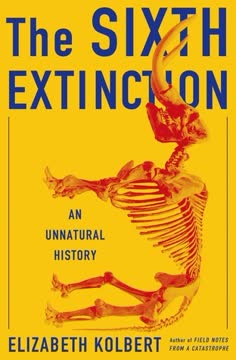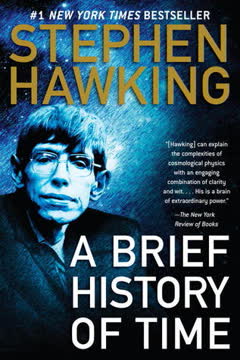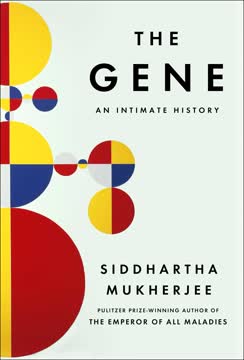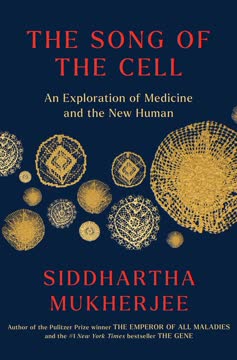Key Takeaways
1. The Gene: A Unit of Heredity Discovered and Defined.
Just as physics and chemistry go back to molecules and atoms, the biological sciences have to penetrate these units [genes] in order to explain . . . the phenomena of the living world.
Fundamental unit. The gene is the basic unit of heredity and biological information, analogous to the atom in matter or the byte in digital information. Understanding this irreducible unit is crucial to understanding the whole organism. Early thinkers like Pythagoras and Aristotle debated how traits were passed, proposing theories like male semen carrying all information or a mix of male "message" and female "material."
Mendel's discovery. Gregor Mendel, an Austrian monk and gardener, discovered the fundamental principles of heredity through meticulous experiments with pea plants in the 1850s and 60s. He showed that traits are determined by independent, indivisible particles (later called genes) that are inherited from parents, with some being dominant and others recessive. His work, published in 1866, was ignored for decades.
Rediscovery and definition. Mendel's work was independently rediscovered by three scientists in 1900. William Bateson championed Mendel's ideas and coined the term "genetics" in 1905. Wilhelm Johannsen coined the term "gene" in 1909, defining it as a functional unit of heredity, even though its physical nature was unknown. This marked the birth of modern genetics.
2. Early Misunderstandings Led to the Perversion of Genetics into Eugenics.
When power is discovered, man always turns to it.
Galton and eugenics. Francis Galton, Darwin's cousin, sought to apply principles of heredity to improve the human race, coining the term "eugenics" in 1883. He believed that desirable traits like intelligence were inherited and could be enhanced through selective breeding, advocating for "positive eugenics" (encouraging the fit to breed). His ideas were based on flawed statistical models of inheritance, not Mendelian genetics.
Descent into negative eugenics. Eugenics quickly shifted from encouraging the "fit" to breed to preventing the "unfit" from reproducing ("negative eugenics"). Fueled by anxieties about class, race, and immigration, particularly in the US and Europe, this led to state-sponsored programs.
- Forced sterilization laws were enacted in many US states, targeting individuals deemed "feebleminded," criminals, or mentally ill.
- The Buck v. Bell Supreme Court case in 1927 upheld forced sterilization, famously stating, "Three generations of imbeciles is enough."
Nazi racial hygiene. The most horrific manifestation of eugenics was the Nazi program of "racial hygiene." Based on distorted genetic theories, it led to the forced sterilization and mass murder of millions deemed genetically or racially "unfit," including Jews, Gypsies, and the disabled. This period permanently stained the reputation of eugenics.
3. DNA: The Chemical and Structural Basis of the Gene.
The most important biological objects had to come in pairs.
Searching for the molecule. For decades, the gene remained an abstract unit. Scientists knew genes were on chromosomes, but not what they were made of or how they worked. Proteins were initially favored as the carriers of genetic information due to their complexity. DNA was considered a "stupid molecule."
Avery's transforming principle. In 1944, Oswald Avery's experiment with bacteria showed that DNA, not protein, carried the "transforming principle" of heredity. Heat-killed virulent bacteria could transfer genetic information to harmless bacteria, making them virulent, and the active agent was DNA. This provided the first strong evidence that DNA was the gene molecule.
The double helix. In 1953, James Watson, Francis Crick, Maurice Wilkins, and Rosalind Franklin solved the three-dimensional structure of DNA: a double helix. This structure, with its complementary base pairing (A with T, G with C), immediately suggested how genetic information could be stored and copied, revealing the physical basis of heredity.
4. How Genes Work: Regulation, Replication, and Development.
The genome contains not only a series of blue-prints [i.e., genes], but a co-ordinated program . . . and a means of controlling its execution.
Gene action. George Beadle and Edward Tatum showed that genes "act" by encoding proteins, specifically enzymes that control metabolic processes. This established the link between genetic information and biological function.
Regulation. Jacques Monod and François Jacob discovered that genes are not always active but can be turned "on" and "off" by regulatory proteins in response to environmental cues. This gene regulation explains how different cells in an organism, despite having the same genes, perform different functions.
Replication and development. The double helix structure suggested how DNA replicates, with each strand serving as a template. Arthur Kornberg isolated the enzyme (DNA polymerase) that copies DNA. Genes also orchestrate the complex process of embryonic development, acting in cascades and hierarchies to specify cell fates and build organisms, as shown by studies in flies and worms.
5. Reading and Writing Genes: The Revolution in Technology.
By learning to manipulate genes experimentally, you could learn to manipulate organisms experimentally.
Gene cloning. In the early 1970s, Paul Berg, Herbert Boyer, and Stanley Cohen developed techniques to cut and paste DNA fragments from different organisms, creating "recombinant DNA." They could insert foreign genes into bacterial plasmids and use bacteria as factories to make millions of copies of these genes ("gene cloning"). This allowed scientists to isolate and amplify specific genes.
Gene sequencing. Frederick Sanger developed methods to "read" the precise sequence of bases (A, C, T, G) in a DNA strand. His method, perfected in the late 1970s, made it possible to decipher the genetic code of any organism, starting with small viruses.
Transformative impact. These technologies revolutionized biology. Genes, once inaccessible, could now be read, written, and manipulated in test tubes and living cells. This enabled the study of gene function with unprecedented detail and led to the birth of the biotechnology industry, producing medicines like insulin from genetically engineered bacteria.
6. Human Genetics: Mapping Disease and Diversity.
The proper study of mankind is man.
Mapping human genes. The ability to read and write genes spurred the study of human genetics. Victor McKusick cataloged thousands of human diseases linked to genes. Techniques like linkage analysis and positional cloning, pioneered by scientists like David Botstein and Nancy Wexler, allowed researchers to map disease-causing genes to specific locations on human chromosomes, leading to the identification of genes for diseases like Huntington's and cystic fibrosis.
The Human Genome Project. The ultimate goal was to sequence the entire human genome. Launched in 1990, the Human Genome Project, led by James Watson and later Francis Collins, aimed to read all 3 billion base pairs. A parallel private effort led by Craig Venter used a faster "shotgun" sequencing method. The draft sequence was announced in 2000, providing a reference map of human genes.
Human origins and diversity. Genomic studies revealed that modern humans originated in Africa relatively recently (~200,000 years ago) and migrated globally. Genetic diversity is highest in Africa and decreases with distance from Africa. While we are genetically very similar as a species, most genetic variation exists within traditional racial groups, not between them, making race a poor predictor of individual genetic traits.
7. Genes, Identity, and the Complexity of Fate.
So, we’s the same. Just a different color.
Genes and identity. Beyond disease, genetics began to explore the influence of genes on identity, behavior, and temperament. Studies on twins reared apart showed striking similarities in personality, attitudes, and even specific behaviors, suggesting a strong genetic component independent of environment.
Sex and gender. Genes play a fundamental role in determining biological sex (XY vs. XX chromosomes, with the SRY gene on the Y chromosome being a master switch for maleness). While gender identity is complex, studies suggest genes are highly influential, challenging purely environmental explanations.
Temperament and behavior. Genes are linked to aspects of temperament like novelty seeking and impulsivity, often through variants in genes affecting brain signaling. However, these links are often probabilistic, influencing propensities rather than rigidly determining outcomes. The effect of genes on complex traits is often polygenic (involving multiple genes) and heavily influenced by environment and chance.
8. The Future of the Genome: Editing and Ethical Challenges.
Those who promise us paradise on earth never produced anything but a hell.
Gene therapy returns. After setbacks like Jesse Gelsinger's death, gene therapy has advanced with safer viral vectors and better targeting, showing success in treating diseases like hemophilia. This involves altering non-reproductive cells.
Epigenetics. Beyond the DNA sequence, chemical marks on DNA and associated proteins (epigenetics) can influence gene expression and be heritable, showing how environment can leave its mark on the genome and potentially across generations.
Genome editing. New technologies like CRISPR/Cas9 allow scientists to make precise, intentional changes to specific genes. This offers unprecedented power to correct mutations or introduce new genetic information.
Germ-line engineering. The ability to edit genes in human embryonic stem cells and potentially convert them into sperm and eggs raises the prospect of permanently altering the human genome for future generations. This technology, while still developing, is becoming feasible. It raises profound ethical questions about "enhancing" humans and who decides what constitutes an improvement, echoing the dark history of eugenics.
Last updated:
FAQ
1. What is The Gene: An Intimate History by Siddhartha Mukherjee about?
- Comprehensive history of genetics: The book traces the discovery and evolution of the gene, from Mendel’s pea experiments to modern genome editing technologies like CRISPR.
- Personal and scientific narrative: Mukherjee weaves his family’s history of mental illness with the broader scientific quest to understand heredity, making the story both intimate and universal.
- Exploration of ethical and societal implications: The narrative delves into the moral dilemmas, societal consequences, and philosophical questions raised by genetic knowledge and manipulation.
2. Why should I read The Gene: An Intimate History by Siddhartha Mukherjee?
- Bridges science and humanity: The book connects complex genetic science with personal stories and historical events, making the subject accessible and emotionally resonant.
- Insight into genetics’ impact: Readers gain an understanding of how genetics has shaped medicine, society, and politics, including the dark history of eugenics and the promise and peril of gene editing.
- Thought-provoking ethical questions: Mukherjee invites readers to consider who controls genetic knowledge and how it might redefine what it means to be human.
3. What are the key takeaways from The Gene: An Intimate History by Siddhartha Mukherjee?
- Genes are not destiny: The book emphasizes the complex interplay between genes, environment, and chance in shaping identity, health, and behavior.
- History informs the present: Understanding the history of genetics, including its misuse in eugenics, is crucial for navigating current and future ethical challenges.
- Revolutionary technologies: Advances like gene therapy and CRISPR/Cas9 have the potential to transform medicine and human evolution, but require careful ethical consideration.
- Human identity and diversity: The narrative challenges simplistic notions of race, gender, and normalcy, highlighting the richness and complexity of human genetic variation.
4. What are the key scientific concepts explained in The Gene: An Intimate History by Siddhartha Mukherjee?
- Gene as hereditary unit: Genes are discrete units of biological information that determine traits and are passed from parents to offspring.
- DNA structure and function: The discovery of the double helix by Watson and Crick, informed by Franklin’s X-ray images, revealed how genetic information is stored and replicated.
- Central dogma and gene regulation: The flow of genetic information from DNA to RNA to protein, and the regulation of gene expression, explain how identical genomes produce diverse cell types.
- Epigenetics and genome complexity: Chemical modifications to DNA and histones regulate gene activity without changing the sequence, adding layers of complexity to heredity and development.
5. How does The Gene: An Intimate History by Siddhartha Mukherjee explain the history and rediscovery of genetics?
- Mendel’s foundational experiments: Mendel’s work on pea plants established the principles of discrete inheritance, dominant and recessive traits, and mathematical ratios in heredity.
- Neglect and rediscovery: Mendel’s findings were ignored for decades until rediscovered around 1900, leading to the birth of genetics as a scientific discipline.
- Integration with evolution: The Modern Synthesis reconciled Mendelian genetics with Darwinian evolution, explaining variation, natural selection, and speciation.
- Expansion of genetic understanding: The book traces the journey from early gene concepts to the molecular era, including the identification of DNA as the genetic material.
6. How does The Gene: An Intimate History by Siddhartha Mukherjee describe the discovery of DNA’s structure and function?
- X-ray crystallography and model building: Rosalind Franklin’s X-ray diffraction images provided critical evidence for the helical structure of DNA, which Watson and Crick used to build their double helix model.
- Base pairing and replication: The model explained how adenine pairs with thymine and guanine with cytosine, revealing the mechanism for accurate DNA replication.
- Biological significance: The double helix structure clarified how genetic information is stored, copied, and transmitted, revolutionizing biology and medicine.
- Scientific rivalry and collaboration: The story includes the competitive and collaborative dynamics among scientists, highlighting the human side of discovery.
7. What is the “central dogma” of molecular biology as explained in The Gene: An Intimate History by Siddhartha Mukherjee?
- Information flow: The central dogma describes the flow of genetic information from DNA to RNA to protein, with DNA transcribed into mRNA and then translated into proteins.
- Triplet genetic code: The genetic code is read in triplets (codons), each specifying an amino acid, explaining how four bases encode twenty amino acids.
- Universality: This process is universal across living organisms, underpinning the unity of life and the function of genes in specifying biological traits.
8. How does The Gene: An Intimate History by Siddhartha Mukherjee address gene regulation and embryonic development?
- Selective gene expression: Genes can be turned on or off depending on environmental cues, developmental stage, or cell type, enabling cellular diversity.
- Lac operon and regulatory models: The book explains how groups of genes are regulated together, as in the lac operon, illustrating coordinated gene control.
- Master regulatory genes: Genes control the identity of body segments and organs, orchestrating the development of complex organisms through gene cascades.
- Epigenetic regulation: Chemical modifications to DNA and histones allow for heritable changes in gene expression, influencing development and cellular memory.
9. What does The Gene: An Intimate History by Siddhartha Mukherjee reveal about the Human Genome Project and genome sequencing?
- Ambitious scale: The Human Genome Project aimed to sequence all 3 billion base pairs of human DNA, providing a comprehensive reference for research and medicine.
- Technological breakthroughs: Innovations like Sanger sequencing and shotgun sequencing enabled rapid progress, with public and private teams racing to complete the genome.
- Impact on biology and medicine: Genome sequencing transformed genetics from studying individual genes to understanding entire genomes, enabling advances in disease diagnosis, personalized medicine, and evolutionary biology.
- Complexity of the genome: The project revealed that gene number does not correlate with organism complexity, highlighting the importance of gene regulation and noncoding DNA.
10. How does The Gene: An Intimate History by Siddhartha Mukherjee discuss the history and impact of eugenics?
- Origins and ideology: Eugenics, coined by Francis Galton, aimed to improve human populations through selective breeding and sterilization, gaining early 20th-century popularity.
- Social and political consequences: Eugenics influenced policies promoting sterilization and segregation, culminating in abuses like the Buck v. Bell case and Nazi racial hygiene programs.
- Moral caution: Mukherjee highlights the dangers of misapplying genetic science to social policy, emphasizing the complexity of heredity and the ethical pitfalls of genetic determinism.
- Legacy and modern parallels: The book contrasts historical eugenics with modern genetic screening and therapy, urging careful consideration of moral boundaries.
11. What are the ethical and societal implications of genetics and genome editing discussed in The Gene: An Intimate History by Siddhartha Mukherjee?
- Genetic determinism vs. complexity: The book warns against simplistic views that genes alone determine identity, behavior, or fate, emphasizing gene-environment interactions.
- Genome editing technologies: Advances like CRISPR/Cas9 enable precise genetic modifications, raising questions about therapy versus enhancement and the potential for permanent changes to the human genome.
- Privacy, identity, and diversity: Genetic knowledge can alter how societies view race, sexuality, and personal identity, with potential for discrimination or empowerment.
- Calls for regulation and debate: Mukherjee stresses the need for public discourse, regulation, and ethical frameworks to guide the use of powerful genetic technologies.
12. What are the best quotes from The Gene: An Intimate History by Siddhartha Mukherjee and what do they mean?
- “Human beings are ultimately nothing but carriers—passageways—for genes.” (Haruki Murakami) This highlights the gene-centered view of biology, where organisms serve as vehicles for gene propagation.
- “The difference between ‘human’ and ‘breakfast cereal’ is not a matter of gene numbers, but of the sophistication of gene networks.” This underscores that biological complexity arises from gene regulation, not just gene count.
- “Three generations of imbeciles is enough.” (Justice Holmes, Buck v. Bell) A chilling example of how genetic science was misused to justify forced sterilizations.
- “We will learn to read and write our selves, ourselves.” This expresses the transformative potential of genomics and gene editing to understand and alter human biology.
Review Summary
The Gene: An Intimate History is widely praised for its accessible yet comprehensive exploration of genetics. Readers appreciate Mukherjee's engaging writing style, which weaves personal anecdotes with scientific history. The book covers the evolution of genetic research, ethical implications, and future possibilities. Many find it enlightening and thought-provoking, though some struggle with its length and complexity. Critics note occasional inaccuracies but generally commend the book's balanced perspective on genetic advancements. Overall, it's considered a must-read for those interested in genetics and its impact on society.
Similar Books










Download PDF
Download EPUB
.epub digital book format is ideal for reading ebooks on phones, tablets, and e-readers.







